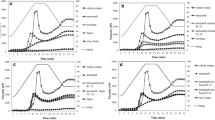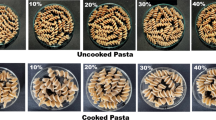Abstract
Due to its bioactive compounds, blue maize flour is a valuable ingredient for developing gluten-free products. The incorporation of alternative flours into gluten-free pasta is a challenge as it usually results in products that, despite their enhanced nutraceutical features, show reduced quality characteristics. Composite pasta was prepared with variable (25, 50 and 75%) contents of flours from white and blue maize, chickpea and unripe plantain, following a laboratory-scale process. The composite pasta exhibited acceptable cooking loss (9–11%); pasta with blue maize showed lower hardness and chewiness, but higher adhesiveness than its white maize-based counterpart. Blue maize-based pasta presented dark color. The addition of blue maize flour at 75% conveyed the highest total phenolic content retention after extrusion (80%) and cooking (70%). Pasting profile of blue maize pasta (50 and 75%) showed a defined second viscosity peak due to re-arrangement of starch components upon cooling. The observed retention of phenolic compounds with antioxidant capacity after cooking will be useful for further development (selection of ingredients, formulations and conditions of operation) of gluten-free products with potential health benefits.




Similar content being viewed by others
References
AACC (2000). Approved methods of the American Association of Cereal Chemists, 10th ed. (vols 1 and 2)
Aguayo-Rojas J, Mora-Rochín S, Cuevas-Rodríguez EO, Serna-Saldivar SO, Gutierrez-Uribe JA, Reyes-Moreno C, Milán-Carrillo J (2012) Phytochemicals and antioxidant capacity of tortillas obtained after lime-cooking extrusion process of whole pigmented Mexican maize. Plant Foods Hum Nutr 67:178–185. https://doi.org/10.1007/s11130-012-0288-y
Bello-Pérez LA, Flores-Silva PC, Camelo-Mendez GA (2014) Non-conventional flours in the development of gluten-free food products. In: Langdon RT (ed) Gluten-free diets: food sources, role in celiac disease and health benefits. Nova Publishers, New York, pp 223–237
Bello-Pérez LA, Flores-Silva PC, Camelo-Méndez GA, Paredes-López O, Figueroa-Cárdenas JD (2015) Effect of the nixtamalization process on the dietary fiber content, starch digestibility, and antioxidant capacity of blue maize tortilla. Cereal Chem 92(3):265–270. https://doi.org/10.1094/CCHEM-06-14-0139-R
Bello-Pérez LA, Camelo-Méndez GA, Agama-Acevedo E, Utrilla-Coello RG (2016) Nutraceutic aspects of pigmented maize: digestibility of carbohydrates and anthocyanins. Agrociencia 50:1041–1063
Benzie IFF, Strain JJ (1996) The ferric reducing ability of plasma (FRAP) as a measure of “antioxidant power”: the FRAP assay. Anal Biochem 239:70–76
Bordenave N, Hamaker BR, Ferruzzi MG (2014) Nature and consequences of non-covalent interactions between flavonoids and macronutrients in foods. Food Funct 5:18–34. https://doi.org/10.1039/c3fo60263j
Camelo-Méndez GA, Agama-Acevedo E, Tovar J, Bello-Pérez LA (2017) Functional characterization of raw and cooked blue maize flour: starch digestibility, total phenolic content and antioxidant activity. J Cereal Sci 76:179–185. https://doi.org/10.1016/j.jcs.2017.06.009
Chávez-Salazar A, Bello-Pérez LA, Agama-Acevedo E, Castellanos-Galeano FJ, Álvarez-Barreto CI, Pacheco-Vargas G (2017) Isolation and partial characterization of starch from banana cultivars grown in Colombia. Int J Biol Macromol 98:240–246. https://doi.org/10.1016/j.ijbiomac.2017.01.024
Del Pozo-Insfran D, Serna-Saldivar SO, Brenes CH, Talcott ST (2007) Polyphenolics and antioxidant capacity of white and blue corns processed into tortillas and chips. Cereal Chem 84:162–168. https://doi.org/10.1094/CCHEM-84-2-0162
Fares C, Platani C, Baiano A, Menga V (2010) Effect of processing and cooking on phenolic acid profile and antioxidant capacity of durum wheat pasta enriched with debranning fractions of wheat. Food Chem 119(3):1023–1029. https://doi.org/10.1016/j.foodchem.2009.08.006
Flores-Silva PC, Berrios JDJ, Pan J, Osorio-Díaz P, Bello-Pérez LA (2014) Gluten-free spaghetti made with chickpea, unripe plantain and maize flours: functional and chemical properties and starch digestibility. Int J Food Sci Tech 49(9):1985–1991. https://doi.org/10.1111/ijfs.12529
Flores-Silva PC, Berrios JDJ, Pan J, Agama-Acevedo E, Monsalve-González A, Bello-Pérez LA (2015) Gluten-free spaghetti with unripe plantain, chickpea and maize: physicochemical, texture and sensory properties. CYTA-J Food 13(2):159–166. https://doi.org/10.1080/19476337.2014.929178
Fu BX (2008) Asian noodles: history, classification, raw materials, and processing. Food Res Int 41:888–902. https://doi.org/10.1016/j.foodres.2007.11.007
Gallegos-Infante JA, Rocha-Guzman NE, Gonzalez-Laredo FR, Ochoa-Martínez LA, Corzo N, Bello-Perez LA, Medina-Torres L, Peralta-Alvarez LE (2010) Quality of spaghetti pasta containing Mexican common bean flour (Phaseolus vulgaris L.). Food Chem 119:1544–1549. https://doi.org/10.1016/j.foodchem.2009.09.040
Islas-Rubio AR, Calderón de la Barca AM, Cabrera-Chávez F, Cota-Gastélum AG, Beta T (2014) Effect of semolina replacement with a raw: popped amaranth flour blend on cooking quality and texture of pasta. LWT Food Sci Technol 57(1):217–222. https://doi.org/10.1016/j.lwt.2014.01.014
Khan I, Yousif A, Johnson SK, Gamlath S (2013) Effect of sorghum flour addition on resistant starch content, phenolic profile and antioxidant capacity of durum wheat pasta. Food Res Int 54:578–586. https://doi.org/10.1016/j.foodres.2013.07.059
Khan I, Yousif AM, Johnson SK, Gamlath S (2014) Effect of sorghum flour addition on in vitro starch digestibility, cooking quality, and consumer acceptability of durum wheat pasta. J Food Sci 79(8):S1560–S1567. https://doi.org/10.1111/1750-3841.12542
Liu L, Herald TJ, Wang D, Wilson JD, Bean SR, Aramouni FM (2012) Characterization of sorghum grain and evaluation of sorghum flour in a chinese egg noodle system. J Cereal Sci 55(1):31–36. https://doi.org/10.1016/j.jcs.2011.09.007
Naczk M, Towsend M, Zadernowski R, Shahidi F (2011) Protein-binding and antioxidant potential of phenolics of mangosteen fruit (Garcinia mangostana). Food Chem 128(2):292–298. https://doi.org/10.1016/j.foodchem.2011.03.017
Ovando-Martinez M, Sáyago-Ayerdi S, Agama-Acevedo E, Goñi I, Bello-Pérez LA (2009) Unripe banana flour as an ingredient to increase the undigestible carbohydrates of pasta. Food Chem 113:121–126. https://doi.org/10.1016/j.foodchem.2008.07.035
Palavecino PM, Bustos MC, Heinzmann Alabí MB, Nicolazzi MS, Penci MC, Ribotta PD (2017) Effect of ingredients on the quality of gluten-free sorghum pasta. J Food Sci 82(9):2085–2093. https://doi.org/10.1111/1750-3841.13821
Parmar N, Singh N, Kaur A, Thakur S (2017) Comparison of color, antinutritional factors, mineral, phenolic profile and protein digestibility between hard-to-cook and easy-to-cook grains from different kidneay bean (Phaseolus vulgaris) accessions. J Food Sci Technol 54(4):1023–1034
Petitot M, Boyer L, Minier C, Micard V (2010) Fortification of pasta with split pea and faba bean flours: pasta processing and quality evaluation. Food Res Int 43:634–641
Re R, Pellegrini N, Proteggente A, Pannala A, Yang M, Rice-Evans C (1999) Antioxidant activity applying an improved ABTS radical cation decolorization assay. Free Radic Biol Med 26:1231–1237
Singh N, Nakura Y, Inouchi N, Nishinari K (2008) Structure and viscoelastic properties of starches separated from different legumes. Starch/Stärke 60:349–357
Sözer N, Kaya A (2003) Changes in cooking and textural properties of spaghetti cooked with different levels of salt in the cooking water. J Texture Stud 34(4):381–390. https://doi.org/10.1111/j.1745-4603.2003.tb01070.x
Sumczynski D, Kotásková E, Družbíková H, Mlček J (2016) Determination of contents and antioxidant activity of free and bound phenolics compounds and in vitro digestibility of commercial black and red rice (Oryza sativa L.) varieties. Food Chem 211:339–346
Thakur S, Kaur A, Singh N, Virdi AS (2015) Successive reduction dry milling of normal and waxy corn: grain, grift, and flour properties. J Food Sci 80(6):C1144–C1155
Thakur S, Singh N, Kaur A, Singh B (2017) Effect of extrusion on physicochemical properties, digestibility, and phenolic profiles of grift fractions obtained from dry millingof normal and waxy corn. J Food Sci 82(5):1101–1109
Tudoricǎ CM, Kuri V, Brennan CS (2002) Nutritional and physicochemical characteristics of dietary fiber enriched pasta. J Agric Food Chem 50(2):347–356. https://doi.org/10.1021/jf0106953
Urias-Lugo DA, Heredia JB, Muy-Rangel MD, Valdez-Torres JB, Serna-Saldívar SO, Gutiérrez-Uribe JA (2015) Anthocyanins and phenolic acids of hybrid and native blue maize (Zea mays L.) extracts and their antiproliferative activity in mammary (MCF7), liver (HepG2), colon (Caco2 and HT29) and prostate (PC3) Cancer Cells. Plant Foods Hum Nutr 70:193–199. https://doi.org/10.1007/s11130-015-0479-4
Vamadevan V, Bertoft E (2015) Structure-function relationships of starch components. Starch Stärke 67(1–2):55–68. https://doi.org/10.1002/star.201400188
Verardo V, Arraez-Roman D, Segura-Carretero A, Marconi E, Fernandez-Gutierrez A, Caboni MF (2011) Determination of free and bound phenolic compounds in buckwheat spaghetti by RP-HPLC–ESI-TOF-MS: effect of thermal processing from farm to fork. J Agric Food Chem 59(14):7700–7707. https://doi.org/10.1021/jf201069k
Acknowledgements
The authors thank the support from CONACYT, México, SIP-IPN, COFAA-IPN, and EDI-IPN. One of the authors (GACM) also acknowledges a scholarship from CONACYT, Mexico.
Author information
Authors and Affiliations
Corresponding author
Rights and permissions
About this article
Cite this article
Camelo-Méndez, G.A., Tovar, J. & Bello-Pérez, L.A. Influence of blue maize flour on gluten-free pasta quality and antioxidant retention characteristics. J Food Sci Technol 55, 2739–2748 (2018). https://doi.org/10.1007/s13197-018-3196-9
Revised:
Accepted:
Published:
Issue Date:
DOI: https://doi.org/10.1007/s13197-018-3196-9




